5-plank open, internal use (1890s style)
RichardG
Western Thunderer
When I started in 7 mm scale, a well-meaning friend explained I could buy wagons RTR for less than the cost of a kit. I bought two Dapol wagons from Hattons - a salt wagon, and this 5-plank open for Chapman and Sons of Croydon.
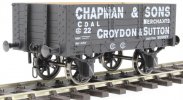
Photo from Hatton’s web site this morning, I forgot to photograph the model before I started.
This wagon has been on the go for most of three years. It is in the style of a RCH wagon, but I’m not sure which standard. It has a 9 ft wheelbase and timber solebars, so it will look okay on the Heybridge Railway.
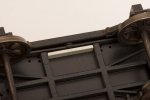
I cut off the the brake gear on one side to backdate it towards the 1887 standard. The block of styrene is holding the compensation bar into place.
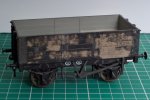
I took an air eraser to the body to remove the pooling symbols. Later I removed the paint from a few planks, and later still I stripped almost everything.
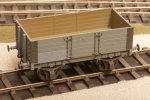
I repainted the model in Railmatch 'Diesel Roof Grey' to use up some paint from a former life and I worked up the underframe too, and the model stayed like this for a couple of years. By now the inside had been repainted three times. Last week I did a test patch with Vallejo 'Medium Sea Grey' but decided the difference wasn’t really worth the effort, and took this off again.
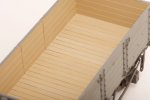
I have however repainted the inside better to try to represent the unpainted planks. This is a varying mixture of Ammo ‘Old Wood’ and ‘New Wood’. I like the variety here. I also think, repainting the interior makes the Diesel Roof Grey look better.
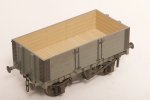
I have dusted some brown powder along the body too, so the model is weathered but not obviously.
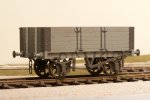
I can attempt the interior ironwork one day but the model may well still be "wrong". A friend has pointed out, the 19th century builders might have used hardwood not softwood for their wagon bodies; these would be a different colour. At the moment I am happy because the interior looks more like wood than it has ever done before, and at the moment it doesn't look out of place. Of course, as time goes by I learn more; and one day I may suddenly decide I know the model is wrong and alter something again.
The back story for this will be, the railway bought the wagon as an ex-demonstrator from the manufacturer. This explains the obvious mileage on the underframe. Whether the 19th century wagon builders actually had demonstrators I don't know, but why not.

Photo from Hatton’s web site this morning, I forgot to photograph the model before I started.
This wagon has been on the go for most of three years. It is in the style of a RCH wagon, but I’m not sure which standard. It has a 9 ft wheelbase and timber solebars, so it will look okay on the Heybridge Railway.

I cut off the the brake gear on one side to backdate it towards the 1887 standard. The block of styrene is holding the compensation bar into place.

I took an air eraser to the body to remove the pooling symbols. Later I removed the paint from a few planks, and later still I stripped almost everything.

I repainted the model in Railmatch 'Diesel Roof Grey' to use up some paint from a former life and I worked up the underframe too, and the model stayed like this for a couple of years. By now the inside had been repainted three times. Last week I did a test patch with Vallejo 'Medium Sea Grey' but decided the difference wasn’t really worth the effort, and took this off again.

I have however repainted the inside better to try to represent the unpainted planks. This is a varying mixture of Ammo ‘Old Wood’ and ‘New Wood’. I like the variety here. I also think, repainting the interior makes the Diesel Roof Grey look better.

I have dusted some brown powder along the body too, so the model is weathered but not obviously.

I can attempt the interior ironwork one day but the model may well still be "wrong". A friend has pointed out, the 19th century builders might have used hardwood not softwood for their wagon bodies; these would be a different colour. At the moment I am happy because the interior looks more like wood than it has ever done before, and at the moment it doesn't look out of place. Of course, as time goes by I learn more; and one day I may suddenly decide I know the model is wrong and alter something again.
The back story for this will be, the railway bought the wagon as an ex-demonstrator from the manufacturer. This explains the obvious mileage on the underframe. Whether the 19th century wagon builders actually had demonstrators I don't know, but why not.




























